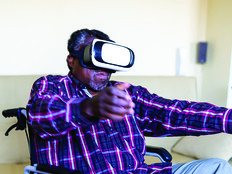How VR Improves Physician Training and Patient Outcomes
Virtual reality technology entered the public eye in the early 1990s, when VR goggles were integrated into arcade machines, allowing users to immerse themselves in stereoscopic 3D visuals and connect to one another in multiplayer games. Years later, the technology was popularized via consumer gaming headsets, which gamers could use to create the same immersive experiences on their home consoles.
Little did we know these were the humble beginnings of what is now a multibillion-dollar market, one that has not just changed how we play, but also how we work.
Today, VR has expanded beyond its gaming origins and is no longer just a niche, recreational technology. VR is a technological innovation driven by strong market insights and financial impact, and has tremendous potential to disrupt some of the most unexpected industries. Goldman Sachs reports commercial spending for virtual reality will overtake consumer spending by 2020 and grow to a projected $80 billion market (combined with augmented reality) by 2025.
The rapid development of technology is also spurring its adoption and commercialization in the business and industrial sectors. Higher visual fidelity helmet-mounted displays and better integrated solutions — along with an increasing comfort level among users — are accelerating the adoption of VR in innovative ways for unexpected industries. The possibilities are endless and attractive to the future world at work, with a forecast of 171 million active virtual reality users by the end of this year.
This technology is set to have an impact on virtually every facet of industry, and healthcare is no exception.
Virtual Reality Tools Revolutionize Healthcare
Imagine, as a medical student, being able to peek over the shoulder of a doctor performing open-heart surgery, getting up close and personal with the intricacies of the complex organ and what is required to repair it. This would be invaluable experience for any student studying to become a surgeon. Now, imagine that same student being able to don a surgical gown and try his or her hand at performing the surgery with no risk to the patient.
Well, there’s no need to imagine: This is the new world of virtual medicine. VR programs are providing practical experience to physicians-in-training by giving them low-stakes, hands-on opportunities to learn. For example, Osso VR is a surgery platform designed by physicians, in which the students can simulate any procedure — from a heart transplant to a knee replacement — with utmost precision.
The benefits of VR may be even more profound when it comes to patient care. For instance, VR can accelerate a patient’s recovery after a stroke. MindMotionPro allows patients to practice lifting their arms and moving their fingers, which helps their traumatized nervous systems recover much faster than lying still in bed.
Moreover, Reimagine Well has created virtual rooms for young patients away from the sterile, white-walled environment of a hospital, as well as VR experiences to help alleviate the anxiety and discomfort of treatment. And the tool VisitU lets patients who are in the hospital participate in important events at home or school, such as birthday parties or graduations, so they stay connected to friends and family.
Already these tools are being put to work: At Cedars-Sinai hospital in Los Angeles, VR helps patients release stress and reduce pain through virtual experiences as diverse as travel, art and swimming. Reducing stress and pain can shorten a patient’s stay and thus decrease cost of care.









